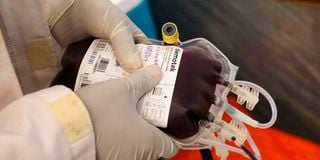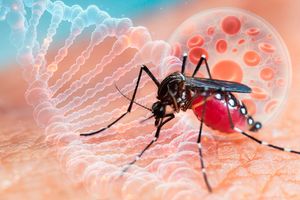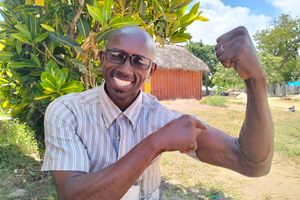Revolutionary blood discovery could save lives of 'impossible to match' patients

A pack of donated blood during a blood donation exercise at Sikh Union in Nairobi on June 23, 2024.
What you need to know:
- When you need a blood transfusion, doctors must make sure the blood you receive matches your blood type perfectly.
- Rare blood types, occurring in less than 1 in 1,000 people, present unique challenges for medical care worldwide.
Scientists have discovered something remarkable in our blood – a new blood type called MAL, solving a mystery that puzzled doctors for 50 years.
The Discovery Explained: Most people (about 98 per cent) have a specific protein called AnWj on their red blood cells. But some rare individuals don't have this protein at all. Until now, doctors didn't fully understand why this happened or how to best help these patients.
"Think of it like a missing puzzle piece," explains Dr Valerie Magutu from the University of Nairobi. "When these rare patients receive normal blood with the protein their body doesn't recognize, their immune system sees it as an invader and fights against it. This can cause serious reactions during blood transfusions."
Why This Matters to You: When you need a blood transfusion, doctors must make sure the blood you receive matches your blood type perfectly. If it doesn't match, your body might reject it, which can be dangerous or even fatal. This new discovery will help doctors better match blood for certain rare patients who have been difficult to help in the past.
Rare blood types, occurring in less than 1 in 1,000 people, present unique challenges for medical care worldwide. The rarest is Rh-null, known as "golden blood," found in fewer than 50 people globally. Other extremely rare types include Bombay blood (1 in 10,000 in India) and Jr(a-) negative (1 in 50,000).
Modern genetic testing
Managing these rare cases requires international cooperation. Blood centres worldwide maintain registries of rare donors and coordinate emergency shipments when needed. When a rare blood type patient is identified, medical teams often test family members, particularly siblings, who may share the same type.
To ensure availability, blood centres freeze rare units for long-term storage (up to 10 years) and maintain contact with known rare donors. Modern genetic testing helps identify potential donors more efficiently, while international databases enable quick location of matching blood units.
Despite these systems, challenges remain: finding compatible donors quickly in emergencies, managing pregnancy in women with rare blood types, and coordinating international blood shipments.
The Breakthrough: After decades of research, scientists in the United Kingdom and Israel finally discovered that this protein difference is significant enough to be classified as its own blood group system – now named MAL. This makes it the 47th known blood group system in humans.
The discovery started with a pregnant woman in 1972 whose blood was missing this common protein. Now, 50 years later, scientists have finally figured out why – it's linked to a specific gene called MAL.
Real-World Impact:
- Doctors can now test specifically for this blood type
- Blood banks can identify rare donors who match these special patients
- Safer transfusions for people who lack this protein
- Better understanding of why some people are born without it
What's Next for Kenya: Dr Joseph Sumba, Clinical Pathologist and Haematologist, KUTRRH, says Kenya needs to study how common this blood type is among its population. "We need local research to understand how this affects Kenyans specifically," he explains. "This will help us improve our blood banking system and ensure safer transfusions for everyone."
Common blood types
The discovery comes at an important time for Kenya, which recently established the Kenya Tissue and Transplant Authority to oversee blood and organ transplants in the country.
Understanding Blood Types: Most people are familiar with the common blood types like A, B, AB, and O. Each blood type has specific markers (called antigens) on the surface of red blood cells. This new MAL blood group adds another important piece to our understanding of human blood types.
The Lead Scientist's View: "Solving this 50-year mystery will help us provide the best care to rare, but important patients," says Louise Tilley, the senior research scientist who led the study. "While these cases are rare, understanding them is crucial for the safety of every patient who needs them."
The research was published in Blood, the American Society of Hematology journal, in 2024.


